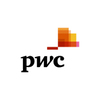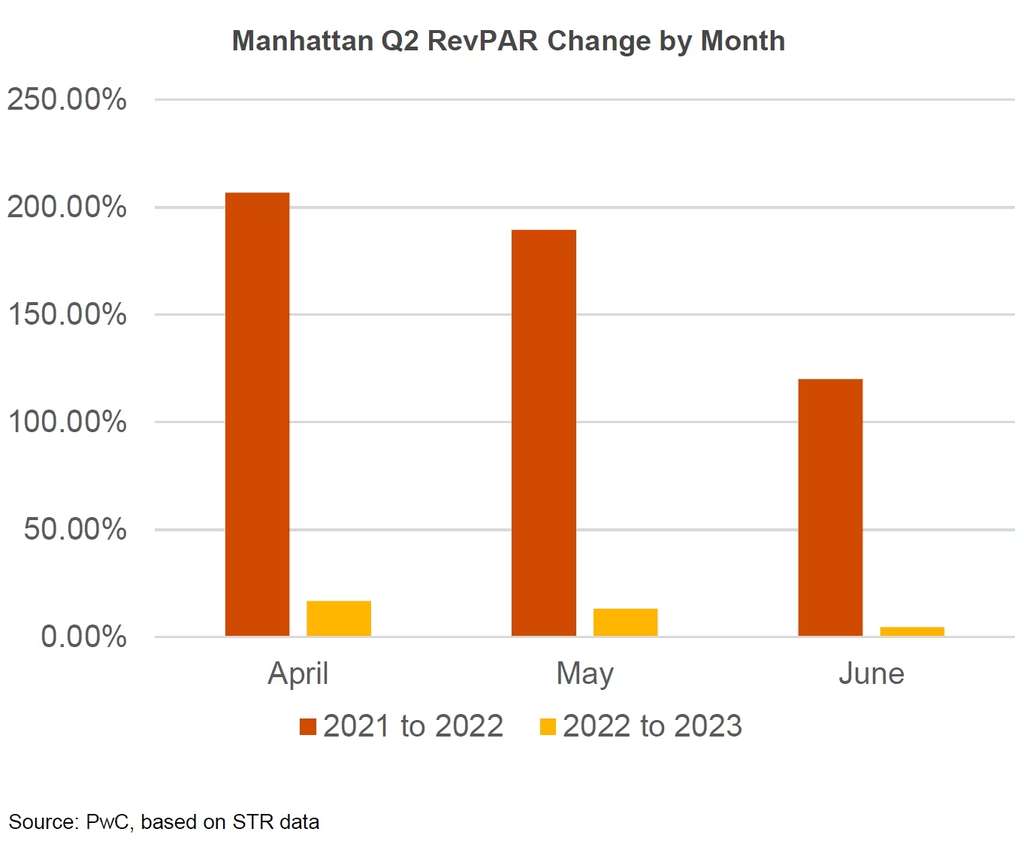Q2 2023 Manhattan Lodging Index
The rate of growth in occupancy, average daily rate and revenue per available room (“RevPAR”) decelerated considerably in Q2, with room rate fatigue effecting growth in the higher-priced hotel categories. H1 RevPAR experienced a year-over-year increase of 23.6%, decelerating each month from a January high of 103.6% to a June low of 4.7%. Q1 RevPAR increased 53.5% while Q2 increased 11.3%, from the same respective periods in 2022.
The rate of growth in occupancy, average daily rate and resultant RevPAR decelerated in each of the first six months of this year, due largely to increasingly difficult comps. With return to office initiatives stagnating and resultant office vacancy rising, hotels reliant on the business transient guest are starting to see growth from that demand segment wane. Warren Marr, Managing Director, PwC
RevPAR increased 11.3 percent year-over-year during the second quarter of 2023. Occupancy and ADR continued to advance, albeit at a slower pace than Q1, with group and corporate travel patterns beginning to stabilize to what could become a new normal. Year-over-year increases in occupancy were highest in April – up 5.1 percent, and lowest in June – up 1.7 percent. With overall occupancy and ADR up to 83.9 percent and $328.28, respectively, Manhattan RevPAR jumped from $247.54 in Q2 2022 to $275.41 in Q2 2023.
Of the four market classes tracked, upper midscale properties exhibited the most significant year-over-year increase in RevPAR - up 21.2 percent for the quarter, driven by a 5.2 percent increase in occupancy from 82.1 percent in 2022 to 86.4 percent in 2023 and a 15.2 percent increase in ADR from $213.29 to $245.62.
For upscale properties, occupancy grew by 3.5 percent and ADR by 11.3 percent in the quarter, resulting in a year-over-year RevPAR increase of 15.1 percent. Upper upscale properties experienced and 11.5 percent increase in RevPAR, driven by a 7.4 percent increase in occupancy and a 3.9 percent increase in ADR. Luxury properties posted the smallest increase in RevPAR – up 0.4 percent, attributable to a decline in occupancy of 1.3 percent and the lowest increase in ADR among the market classes – up 1.8 percent.
Of the five Manhattan neighborhoods, Midtown West had the largest increase in RevPAR - up 15.4 percent, driven by a 9.8 percent increase in ADR and a 5.2 percent increase in occupancy year-over-year. Midtown South RevPAR grew by 10.4 percent, driven by an 8.6 percent increase in ADR and a 1.6 percent increase in occupancy. Midtown East and Upper Manhattan posted RevPAR increases of 10.3 and 4.8 percent, respectively. Lower Manhattan had the lowest increase in RevPAR - up 3.2 percent.
During the second quarter, growth in occupancy at limited-service hotels outpaced that of full-service hotels, with year-over-year increases of 4.1 and 3.4 percent, respectively. RevPAR increased 16.6 percent for limited-service properties while full-service hotels saw an increase of 10.1 percent over the same period.
RevPAR in the second quarter increased by 10.7 percent year-over year for both chain-affiliated and independent hotels. The improvement in chain-affiliated hotels was driven by increases in both occupancy and ADR - up 3.9 and 6.6 percent, respectively. Relative to chain-affiliated properties, independent hotels experienced a more robust increase in ADR of 7.8 percent, but milder occupancy growth of 2.7 percent.
About PwC US
PwC US helps organizations and individuals create the value they're looking for. We're a member of the PwC network of firms in 157 countries with more than 195,000 people. We're committed to delivering quality in assurance, tax and advisory services. Tell us what matters to you and find out more by visiting us at www.pwc.com/US. PwC refers to the US member firm, and may sometimes refer to the PwC network. Each member firm is a separate legal entity. Please see www.pwc.com/structure for further details.


